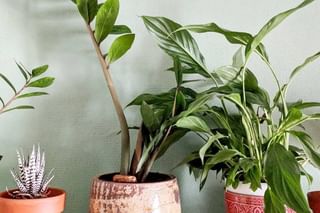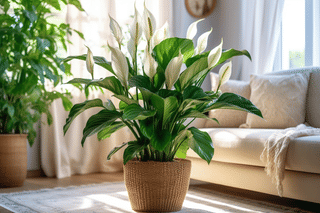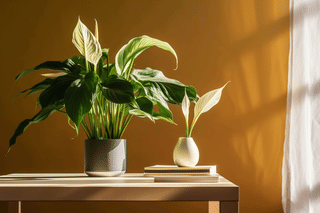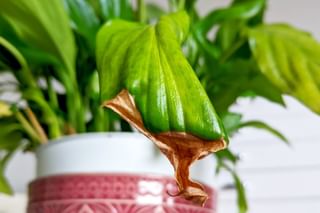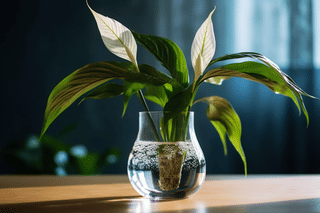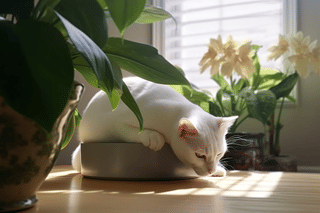How to care for a Peace Lily
The Peace Lily is a plant that requires little maintenance and will show you what it needs. In this plant care guide, we'll go over everything you need to know to take care of a Peace Lily successfully.

If you've ever seen an article about low-light-loving plants, you will probably have heard of the Peace Lily. The Peace Lily is a very easy-going plant that can survive in all kinds of different places in your house. The Peace Lily is a plant that requires little maintenance and will show you when it's not happy. This makes it a perfect plant for beginners, but it's also a great addition to the collection of more experienced plant owners.
In this plant care guide, we'll go over everything you should know about taking care of a Peace lily, and by the end, you'll be able to take care of this plant with ease.
These are the topics we're going to cover:
Let's get right into the first topic: light requirements.
Light requirements for a Peace Lily
The Peace Lily is a great plant for darker places in your house. The Peace Lily should be kept in darker places, as it doesn't do well in bright places. The ideal range of sunlight exposure is low-light to indirect sunlight. It's best to put the Peace Lily in a spot that doesn't get any afternoon sun, as this will be too bright for it in the summer.
A spot that gets afternoon sun in the winter is an option though. Indirect sunlight exposure in the morning or evening in the summer is ideal. This sunlight is not strong enough to burn the Peace Lily's leaves and will give it the energy it needs to grow properly.
On the other hand, if a Peace Lily is placed in too much shade or low-light conditions, it may not flower and may appear dull and lifeless. It's important to find a balance and ensure the plant is getting the right amount of light.
Watering a Peace Lily
Watering a Peace Lily is easy, as this plant is quite a thirsty plant. On average, you should water your Peace Lily at least once per week. However, you might need to water it more or less often, so it's important to check if the top of the soil has dried out before you water it.
If you've accidentally watered the Peace Lily a little too much, there is no problem. This plant will absorb the water quickly. However, if you consistently overwater your peace lily, it could lead to root rot, so make sure to check whether the top of the soil is dry before you water it again.
As long as you give the plant enough time to absorb the water in the pot and let the top soil dry out completely again, you won't overwater this plant. Ideally, plant your Peace Lily in a pot with drainage holes, because any excess water can escape out of the bottom of the pot. This will ensure that you never overwater your plant, not even by accident.
Signs your Peace Lily needs more water
The Peace Lily is an excellent indoor plant that is known for its shiny, dark green leaves and charming white flowers. However, as with all plants, you'll need to water it regularly to help maintain its beauty and health. So, how can you know when it's time to water your Peace Lily?
The first sign that your Peace Lily needs water is when the leaves begin to droop. This happens because the plant is dehydrated and is not getting enough water to survive. But remember, droopy leaves could also happen when it's exposed to lower temperatures or extremely cold water.
Another factor to consider when watering your Peace Lily is the soil's moisture level. If the soil is dry, it means the plant needs water. But if the soil is damp, then wait for a few days to water it, and let the soil dry out. Overwatering the plant can cause root rot and other diseases.
Lastly, check the plant's overall growth rate. If you notice the leaves turning yellow or brown, or if the flowers stop blooming, it means that the plant is not receiving enough water. Make sure that you provide the plant with enough water to promote healthy growth.
The best soil for a Peace Lily
In the previous section, we discovered that the Peace Lily is a thirsty plant that should be watered weekly. To keep your Peace Lily happy, you should choose soil that retains moisture for a few days to a week.
The Peace Lily doesn't store a lot of moisture in its stems, so it won't do well if you have soil that drains well and doesn't retain water for very long. Often, a regular houseplant mix or a palm mix is a perfect choice.
If you want to make the soil retain more water, you can have a look at How to make your soil retain more water?.
The ideal temperature range for a Peace Lily
The Peace Lily is a great houseplant, as it's perfectly adapted to the temperature of the average house during the year. So you won't have to do anything special to keep your Peace Lily happy indoors. But make sure it doesn't get exposed to too much cold air, and keep it away from drafts.
The ideal temperature range for a Peace Lily is 18 - 29℃ (64 - 84℉). So any indoor space should be a great place for your Peace Lily.
Humidity requirements
Peace Lilies are tropical plants that thrive in high-humidity environments. To maintain their health and beauty, they need a humidity level of at least 50% in their surrounding environment. However, humidity levels between 60% and 80% are ideal, and levels below 40% can cause the leaves to yellow and become brittle.
To increase humidity levels around your Peace Lily, misting the leaves daily or placing a tray of water nearby can help. Also, grouping several plants can create a microclimate with higher humidity. It's important to avoid placing the plant near drafty areas or air conditioning vents that can dry out the leaves.
Overall, maintaining a consistent level of humidity is important for the proper growth and care of a Peace Lily. By monitoring humidity levels and taking steps to increase or decrease as needed, you can make sure that your plant remains healthy and vibrant.
Fertilizing a Peace Lily for optimal growth
A Peace Lily is a flowering plant, as you can see in the header photo of this guide, it has slim white flowers. For these flowers to grow, your plant needs to have plenty of additional nutrients and sunlight. If you want these flowers to start growing, you should fertilize your Peace Lily at the beginning of spring. This is when the flowers start to grow and will stick around for a few weeks.
After that, the flowers will dry up and can be pruned. If you give your plant great care, it could flower again at the end of the summer. Apart from fertilizing the plant once at the beginning of the spring, there is no need to fertilize the plant again, as it doesn't need a lot of nutrients to stay healthy. Fertilizing too much could harm the plant.
If you don't want to fertilize your Peace Lily, that's fine too. If your plant doesn't have any extra nutrients, it will simply not grow any flowers. Your plant will still grow leaves as it normally would, but you won't see any flowers. Using fertilizer is only necessary if you want to solve this and have your Peace Lily blooming its white flowers.
Repotting your Peace Lily
Do you have a Peace Lily at home? If so, you might be wondering how often you should repot it. Well, the answer depends on a few things!
If you notice that your Peace Lily has outgrown its pot, it's important to take action quickly to prevent any damage to the plant. A good rule of thumb is to repot your Peace Lily every two years or so, or whenever you notice that the roots are starting to become cramped.
Peace Lilies like being slightly root-bound, so re-potting them too often can be detrimental to their growth. However, if you notice your plant is becoming top-heavy or struggling to absorb water and nutrients, it may be time to consider re-potting it to provide more room for root development. I recommend repotting your peace lily during the spring or summer months, to allow your plant to adjust to its new growing environment quickly.
Make sure to provide fresh soil and choose a pot that is only slightly larger than the current one to avoid over-potting your plant. Begin by gently removing the plant from its old pot and carefully separating the rootball. If the roots are tangled or circling the outside of the rootball, gently loosen them with your fingers or a tool.
Next, place a small amount of fresh potting soil in the bottom of the new pot, then add your Peace Lily and fill in around the rootball with additional potting soil. Be sure to gently press the soil down to remove any air pockets, but not too tightly, and water the plant thoroughly after repotting.
It's important to make sure that the soil is not too tightly packed or soggy. You may also want to trim any brown or damaged leaves from your Peace Lily after repotting to encourage new growth.
Propagating your Peace Lily
You can easily propagate your Peace Lily at home with just a few tools and a little bit of patience.
To start, gently remove the entire plant from its container or pot. Carefully inspect the root system, and using a sterilized pair of scissors or pruning shears, trim away any damaged or discolored roots. Be sure to leave the healthy ones intact.
Next, take a sharp blade and separate the plant at the roots, making sure that each section has at least one healthy stem and several leaves. Once you have divided your Peace Lily into multiple sections, replant each one into a suitable container, making sure to use soil that is rich in nutrients and well-draining.
Place your newly propagated Peace Lilies in a bright, warm location, but not in direct sunlight. Regularly water and mist your plants to keep the soil moist and the humidity levels high. Within a few weeks, your newly propagated Peace Lilies should begin to grow and flourish, just like their parent plant.
Common pests for a Peace Lily
The Peace Lily is quite tough on pests and is immune to a lot of them. It could get Spider mites and mealybugs, but if you keep the leaves clean by wiping them regularly, it won't be a big problem and the pests will be gone quickly. As this plant grows quickly, it'll recover from these pests rather quickly as well.
One of the best and safest ways to clean the leaves is by using a mild soap solution. Mix a few drops of liquid dish soap with water until it becomes sudsy. Then, dip a soft cloth or sponge into the solution and carefully wipe down the top and bottom of each leaf. Make sure to rinse the leaves with clean water afterward to remove any residue from the soap.
Avoid using harsh chemicals or insecticides as they can harm the delicate foliage of the Peace Lily. Regularly cleaning the leaves with a mild soap solution makes the Peace Lily less attractive to pests, and helps to keep it looking vibrant and healthy.
Read more about getting rid of these pests in How to get rid of spider mites on your houseplants and How to get rid of mealybugs on houseplants.
Common problems for a Peace lily
Peace Lilies are known for their easy care and stunning appearance. However, even with proper care, your plant could still deal with problems every once in a while.
Drooping leaves on a Peace Lily
When you see your Peace Lily drooping its leaves, it means that it's too dry and needs to be watered. Make sure you water the plant until the excess water runs out of the bottom of the pot. After you've watered your plant, its leaves will rise again, like nothing ever happened.
Yellowing leaves
When your Peace Lily gets too much sunlight, its leaves will turn light green, and after that, yellow. When you see this happening, it's time to move your Peace Lily to a darker spot and prune the yellow leaves.
Another cause of yellow leaves is overwatering or poor drainage. If you notice the soil is wet, you should water your plant less and make sure the soil still drains moisture quickly.
Leaves that have turned yellow won't turn green again, so it's best to cut these leaves off, to give the rest of the plant nutrients to recover. If the leaves are still light green, they will turn back to their normal dark green color once you've moved the plant back to a darker spot.
Brown tips on a Peace Lily
If you've forgotten to water your Peace Lily for too long, its leaves will get brown and crispy tips like the leaf in the photo. This is the last warning the plant is giving you to water it. The Peace Lily is not a plant that stores a lot of moisture, so it relies heavily on the moisture in the soil.
Peace Lily plants require regular watering, but overwatering can be just as harmful as underwatering. Another reason could be exposure to direct sunlight or high levels of artificial light, which can cause leaf burn.
Another possible cause of brown leaf edges on Peace Lily plants is the presence of chemical toxins in the soil. This may occur if the plant is exposed to air pollution, or if the soil contains pesticides or other harmful chemicals. It's important to use organic, chemical-free soil and to avoid exposing the plant to pollutants.
Additionally, Peace Lilies are sensitive to temperature and humidity changes. If the plant is situated in an area with low humidity or low temperatures, this can cause the edges of the leaves to turn brown.
Like the yellowing leaves, the brown edges won't turn green again, so you should prune these crispy areas. Cutting off the dead parts of the leaf won't harm your plant and improves the overall look of your Peace Lily.
Growing a Peace Lily in water
A method popular among plant enthusiasts is growing the Peace Lily in water instead of soil, also known as water propagation. Peace Lilies are known for their ability to grow in water as they can absorb nutrients directly from the water through their roots.
To grow a Peace Lily in water, you will need to take a healthy cutting from the plant and place it in a container with water. The container should be filled with distilled water or tap water that has been left to sit for 24 hours to reduce chlorine content. If you live in a country where you can drink water straight from the tap, you can also use that water to grow your Peace lily.
You should also change the water every two weeks to prevent bacterial growth, as well as provide the plant with the necessary nutrients by adding a small amount of liquid fertilizer to the water every two to four weeks.
It is important to keep the container in bright, indirect light and away from cold drafts. Peace Lilies are sensitive to temperature changes, so ensure that the water is kept at room temperature. You should also prune the plant regularly to promote growth and prevent overcrowding.
Overall, growing a Peace Lily in water is a great alternative to soil and can be a beautiful addition to your home. Just make sure to provide the plant with the proper care and attention it needs to thrive.
Fertilizing a Peace Lily in water
Fertilizing a peace lily that grows in water is a bit different. Peace lilies are usually easy to take care of, but they need some extra help to grow well and have pretty flowers. When a peace lily grows in water, it can be harder to give it the food it needs to stay healthy.
One of the first things to keep in mind when fertilizing a Peace Lily in water is that you should choose a liquid fertilizer that is created for hydroponic gardening. These types of fertilizers are designed to dissolve easily in water and provide the right balance of nutrients for plants that are grown in water. You can find hydroponic fertilizers at most gardening stores or online.
Before fertilizing your Peace Lily in water, you should make sure that the water is clean and free of any debris or build-up. You may need to change the water or rinse the container if you notice any discoloration or cloudiness.
Once the water is clean, you can add the appropriate amount of hydroponic fertilizer according to the instructions on the label. Be careful not to over-fertilize, as this can harm the plant.
It's also important to note that peace lilies grown in water may not require fertilization as frequently as those grown in soil. Since the water provides a constant source of nutrients, you may only need to fertilize once every two to three months.
However, if you notice that your peace lily is not growing or flowering as well as it should, you may want to fertilize more frequently or increase the amount of fertilizer you use.
Poisonous to pets
Unfortunately, the Peace Lily is poisonous to both cats and dogs. When your pets chew on the leaves, it could irritate your pet's mouth and stomach. The sap in the leaves contains calcium oxalate. This will start to irritate your pet's mouth and stomach after the first bite, which will help your pet to stop eating the leaf and avoid them being seriously harmed.
However, if your pets have eaten parts of the leaves, this could cause them to salivate and show the behavior of trying to get something out of their mouth. Take these signs seriously and call your veterinary when you see this happen.
Due to the Peace Lily being poisonous to pets, keep it out of reach from them and small children as well.
Thank you for reading this post! I hope it helps you to keep your plants healthy and beautiful! If you're looking for more guides on specific plants, you can always request a plant guide to get a guide for the plant you have trouble with.
Test your plant care knowledge
Quiz completed!
Want to learn more? Sign up for my newsletter to receive free tips in your inbox!
Sign up now!